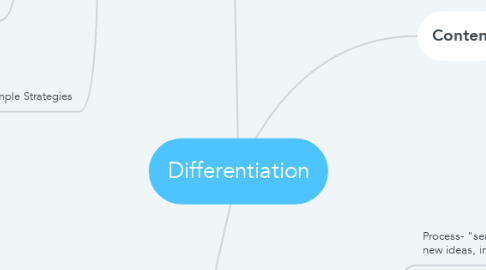
1. Process
1.1. What?
1.1.1. Process- "sense-making" or processing of new ideas, information, and skills
1.1.2. Helping students progress from current point of understanding to a more complex level of understanding.
1.2. How?
1.2.1. Challenge students in these ways:
1.2.1.1. 1. Use range of modes in varying zone.
1.2.1.2. 2. Varied amounts of teacher support.
1.2.1.3. 3. Use essential skills and essential information.
1.2.1.4. 4. To understand, extend, or apply essential ideas or principles.
1.3. Why?
1.3.1. Engage students in different thinking or process skills.
1.4. Example Strategies
1.4.1. help stations
1.4.2. tiered assignments
1.4.3. jigsaw activities
1.4.4. independent studies
1.4.5. learning contracts
1.4.6. interactive journals
2. Product
2.1. What?
2.1.1. Product- means by which student's demonstrate what they're learning
2.2. How?
2.2.1. 3 Ways it can be done:
2.2.1.1. 1. Sense- making activities
2.2.1.1.1. feedback opportunity
2.2.1.1.2. occurs during a span of practice
2.2.1.1.3. formative assessment
2.2.1.1.4. ungraded
2.2.1.2. 2. Performance tasks
2.2.1.2.1. used after more extended learning
2.2.1.2.2. midpoint
2.2.1.2.3. summative and graded
2.2.1.2.4. checks application of learning
2.2.1.3. 3. Products
2.2.1.3.1. Occurs at endpoint
2.2.1.3.2. summative and graded
2.2.1.3.3. checks application of learning
2.2.1.3.4. more open to student interests
2.2.1.3.5. require deeper level of performance
2.2.2. Creating high quality product assignments
2.2.2.1. Identify KUDs
2.2.2.2. identify one or more "packaging options"
2.2.2.3. determine expectations of quality of work
2.2.2.4. scaffolding necessary
2.2.2.5. differentiate based on readiness, learning profile, interest
2.2.2.6. coach for success in all aspects
2.3. Why?
2.3.1. challenge students
2.3.2. clarity of purpose
2.3.3. encourages students to draw on personal interests and strengths
2.4. Example Strategies
2.4.1. design a game
2.4.2. present a mock trial
2.4.3. develop an advertisement
2.4.4. photo essay
3. Content
3.1. What?
3.1.1. Content- the input of teaching and learning.
3.1.2. The objective is not to cover most of the content but to be thoughtful and productive with the content.
3.2. How?
3.2.1. Adapt what we teach and want students to learn
3.2.1.1. Ex. different spelling lists
3.2.2. Adapt how we give students access to the learning.
3.2.2.1. Ex. changing writing prompts
3.2.3. Provide access to different materials
3.2.4. Aligning tasks with learning goals.
3.2.5. Meaningful and skill based instruction
3.3. Why?
3.3.1. Allows students to acquire important information and skills
3.3.2. Makes meaning of learning.
3.3.3. Effectively use and apply knowledge.
3.4. Example strategies
3.4.1. Learning contracts
3.4.2. Note-taking organizers
3.4.3. Reading partners
3.4.4. present in different modes
3.4.5. reading partners
3.4.6. Mini-lessons
